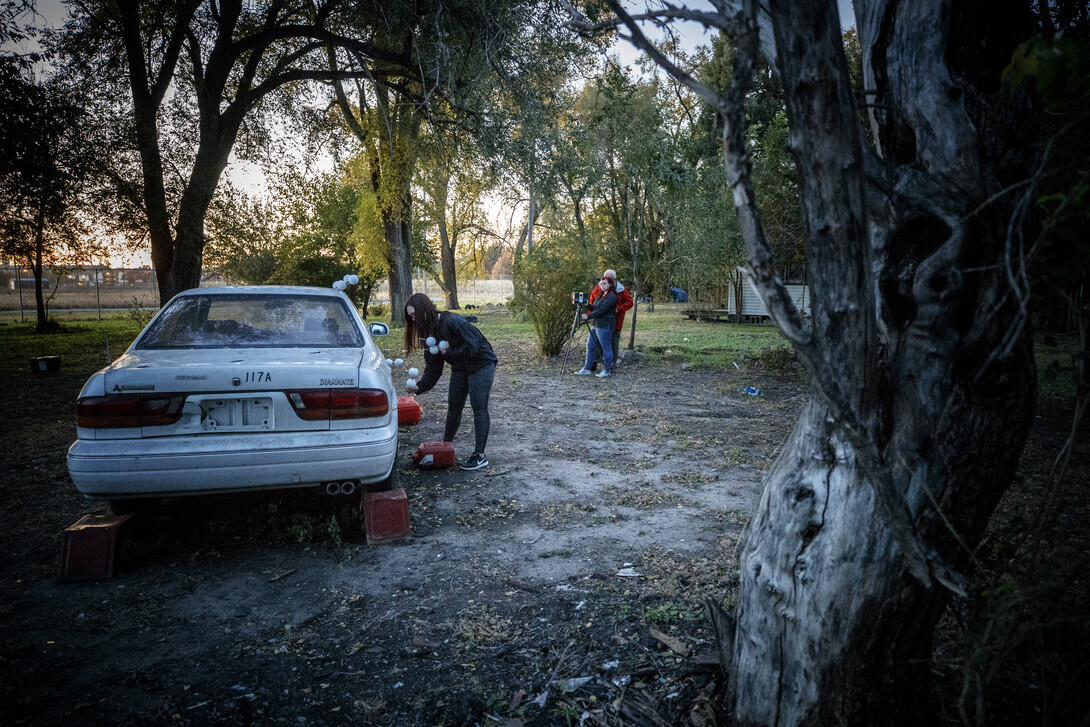
There’s an old house on the University of Nebraska-Lincoln’s East Campus and it might remind passers-by of a Hitchcockian movie set — dilapidated, hidden behind knotty trees, with a peculiar car parked in the yard.
There are murders staged here, just not of the Hollywood variety. Instead, the creepy scenes arranged here train the next generation of crime scene investigators.
The car on the lawn, for example, is riddled with bullet holes and its windows have been busted out. Husker seniors in the forensic science program recently performed 3-D scans to map out the trajectory of the bullets. They also processed the car for trace evidence — anything from soil and pollen to fingerprints and blood.
It’s one of many stations on the property that let students mirror the work of a crime scene investigator in the field.
“Digging things out of dirt, you’re lucky if you get a good fingerprint. It’s not as easy or quick as it seems on T.V.”
– Amy Douglas, a senior forensic science major from Kansas City
Larry Barksdale, assistant professor of practice, has been in charge of re-creating crime scenes on the property. He is a 41-year veteran of the Lincoln Police Department who started teaching crime scene investigation when the forensic science program was launched in 2008 by the College of Agricultural Science and Natural Resources. He consults often with animal science and entomology scholars at Nebraska to make sure students are getting the best re-creations.
Before the university purchased the house in 2016, Barksdale was limited in the types of situations he could reconstruct for students.
“Having this place makes it so much more realistic,” he said. “Trying to find spaces around East Campus that weren’t going to bother someone was really hard to do, so most stuff, like excavations and decomposition, we could only talk about.”

Now, seniors in the program get hands-on experience with many of the real-life scenarios they may face as investigators, including monitoring decomposition; the proper protocols for digging up bones — plastic ones — from shallow graves; measuring tire treads; and photographing evidence. Barksdale said he’ll soon set up a station where blood spatter analysis can be done.
Students who major in forensic science choose one of three tracks — crime scene investigation, forensic biology or forensic chemistry — and take a wide variety of classes in biology, chemistry, entomology, human remains, criminal justice and more before their senior investigation class brings them to the crime scene house.
“Being out here and working on the crime scenes is a culmination of everything these seniors have been learning in class,” Barksdale said.
Forensic science program director Michael Adamowicz said the property has been a boon for students, and was an important addition to one of only a few dedicated forensic science programs in the Midwest.
“It creates an immersive teaching environment,” he said. “There’s a sense of realness because, except for the event, it is real.”

The house’s location on the north end of East Campus, surrounded by agricultural research fields, is also advantageous.
“There are no neighbors that we’re disturbing with experiments or noise or traffic,” he said. “We really have the flexibility to utilize the property any way that we see can benefit our students.”
The property is also used for student and faculty research, and Adamowicz said more plans for the house are in progress. Currently, the interior cannot be used since it was left vacant and fell into disrepair before the university was able to purchase it.
Over the next year, the house will be renovated. Once finished, interior rooms will be staged in endless ways for students to hone their skills in evidence collection and processing. Instructors will be able to watch their work through video feeds without being in the way.
Adamowicz said the program would also like to partner with organizations such as the University of Nebraska–Lincoln Police Department, Lincoln Police Department and Nebraska State Patrol who could conduct trainings there, but also work with students. Partnerships already exist with companies and organizations so that students learn the most cutting-edge technology, such as DNA mapping software, and the 3-D scanner students used, which was donated through a partnership with FARO.
Students said they like being on site performing experiments and collecting evidence.
“We were never able to process a whole crime scene until we got out here,” Diane Sherwin, a senior from Council Bluffs, Iowa, said.
Having the opportunity to use what they’ve learned in the classroom in a real-world setting has taught them some valuable lessons.
“Digging things out of dirt, you’re lucky if you get a good fingerprint,” Amy Douglas, a senior from Kansas City, said. “It’s not as easy or quick as it seems on TV.”







